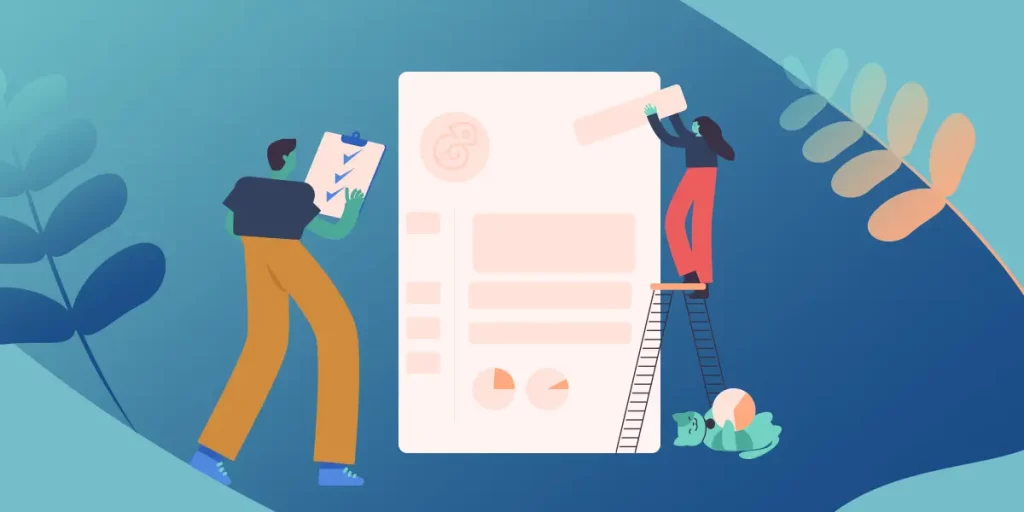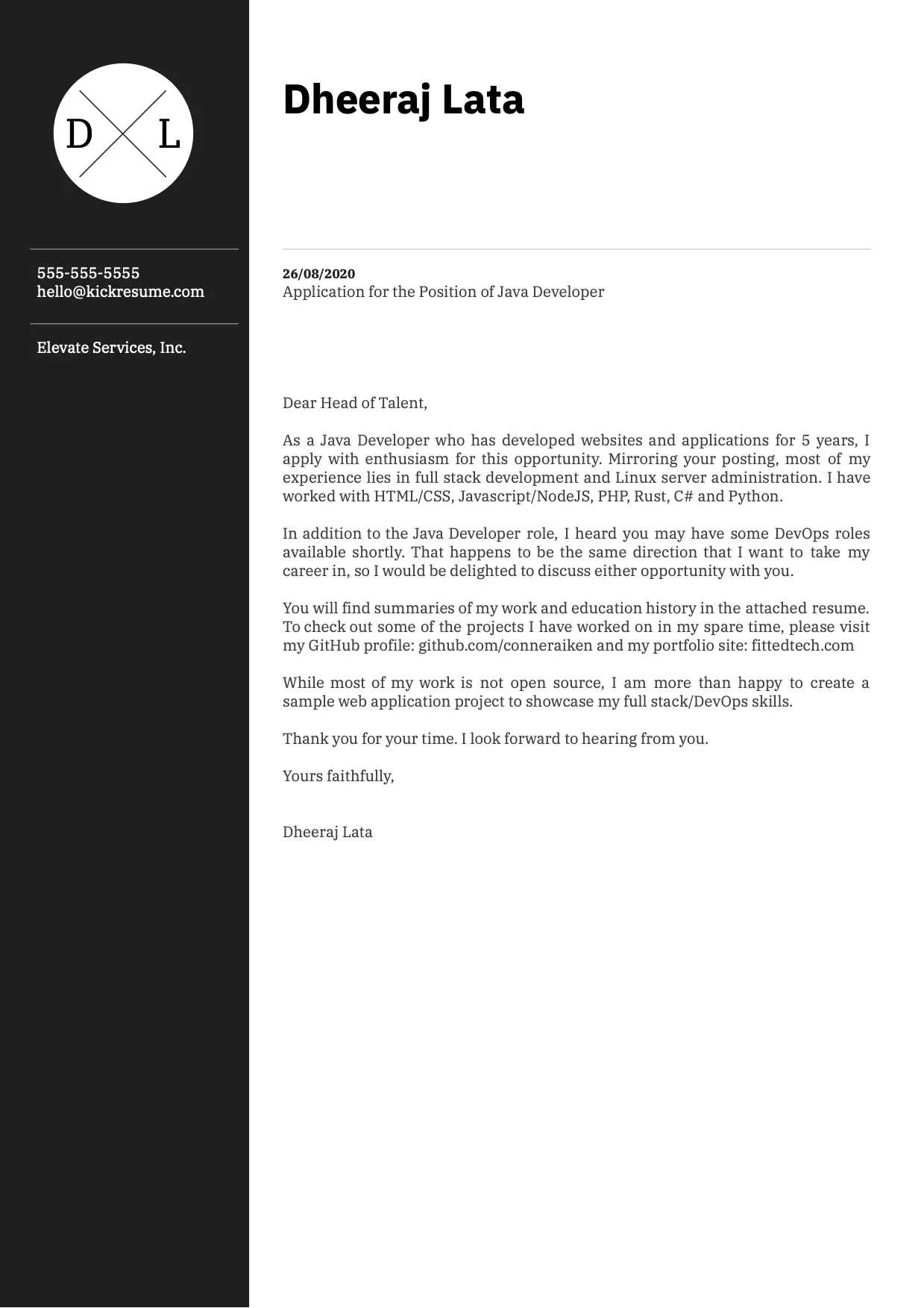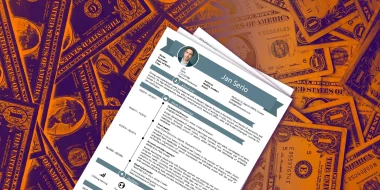Your resume is arguably the most important document you'll create during a job search. So taking the time to learn how to write a resume properly can make a job hunt much quicker and easier.
What would otherwise take you hours of hard work and research can be done in a few minutes. All you have to do is follow our simple step-by-step guide on how to write the perfect resume.
In the end, a good resume gives you a chance to make a great first impression and ultimately decide if you'll be invited for an interview.
What makes a great resume?
- Clear division of resume sections
- Prioritizing relevant information
- Tailored for a specific position
- Typo-free and well-written
- Usage of bullet points
There's more to it, though.
- What is a resume?
- Before you start writing your resume
- How to write a resume
- Step 1: Choose the right resume format
- Step 2: Add contact information and personal details
- Step 3: Begin with your professional summary
- Step 4: List relevant work experience
- Step 5: Summarize your education
- Step 6: Highlight your soft and hard skills
- Step 7: Add optional resume sections
- Step 8: Wrap it up with a cover letter
- Final tips before you click “Send”
What is a resume?
Let's cover the basics first. Before we learn how to write a good resume, we should know what a resume even is.
The word resume comes from French, meaning “summary”. This is the perfect word because that’s exactly what a resume is: a short, straight-to-the-point summary that details your professional achievements, skills, qualifications, education, work experience, and past employers. It's also known as a curriculum vitae (CV).
The aim of a resume is to get invited to a job interview. It should aim to convince an employer that you're a good fit for the job.
Because of that, your resume should be adjusted and tailored to each job vacancy.
TL;DR Here's a step-by-step video guide on how to write a professional resume in 2024
If you’re already familiar with what should be on your resume and just want a quick and informative recap, or if your time is limited, just check out our 5-minute step-by-step video guide.
Before you start writing your resume
Before we move on to how to write a resume, we recommend setting a few minutes aside for research. These few minutes can save you hours of frustration and ultimately make your job search that much easier.
Here’s what we recommend to research before you write your resume:
- Research the company, specifically the “About Us” page. This is a great place to search for keywords you can use in your resume or cover letter. What are their mission statement and their values?
- Research the position you’ll be applying for. Great resumes are tailored to a specific job opening. You can do this by asking these three questions as you go through the job post: “What are the essential keywords? What adjectives, nouns, and phrases occur repeatedly? What language does the company use?”
- Discover your strong points, as this will make it easier to pinpoint the qualities you want to highlight in your resume. Ask people around you: “What are my skills and abilities, and what are my weaknesses?” Also, look at your past accomplishments. What were the skills and abilities that helped you succeed in the past?
Another way of preparing for writing your resume is by looking at these well-researched, specifically tailored, and properly formatted resume examples in our database. You can even filter them by your job title.
How to write a resume
We'll walk you through nine essential steps to help you create a standout resume.
- Choose the right resume format.
Different resume formats cater to different types of job seekers, depending on the experience level and career goals. The three most commonly used resume formats are chronological, functional, and combination (hybrid).
- Add contact information and personal details.
Your resume should include your contact/personal information right at the top, in a so-called resume header. A resume header is more than just your name and contact details. Depending on your career path, there's a lot more that can (and should) be included in this section. To find out what to include, what to skip, and how to format it keep on reading.
- Begin with your professional summary.
A professional summary (also called resume profile or resume summary) is a short paragraph that summarizes your relevant skills, experiences, and achievements. Think of it as a teaser for the rest of your resume.
- List relevant work experience.
This is the most important section of your resume. You need to include key information like: names of companies, locations, job titles, positions held, dates of employment, responsibilities you've had. Then:
- list the jobs in reverse-chronological order
- write in bullet points
- include your quantifiable achievements
- avoid buzzwords
- use action verbs and keywords from the job description - Summarize your education.
The education summary section, though important, varies in significance based on your career stage. As an experienced professional, prioritize work history and skills, placing education after. Keep it concise, including university, degree, and graduation year.
- Highlight your soft and hard skills.
Skills fall into two categories: hard and soft.
1. Hard skills are teachable and measurable, acquired through training, and include computer proficiency, language abilities, project management, etc.
2. Soft skills, linked to personality traits, can enhance both work and personal life, encompassing communication, leadership, and time management, among others. - Add optional resume sections.
These can include: achievements and awards, certifications and licences, language skills, publications, references, hobbies, social media, volunteering, or custom sections.
- Wrap it up with a cover letter.
A good cover letter should answer the following questions:
1. Who are you?
2. Why are you interested in working for their company?
3. Why are you the best fit for the job opening?
4. How can you enrich their company?
In the following chapters, we look at each step in more detail and give you helpful tips and examples.
Step 1: Choose the right resume format
Once you know what the company and job require and you’ve identified your strengths and weaknesses, you should be ready to pick the right resume format.
Make this choice depending on the stage of your career:
- Are you a seasoned professional? Then you should pick a resume format that emphasizes your experience.
- Are you a fresh graduate? Then your resume should highlight any transferable skills you’ve acquired during your studies.
- Are you changing careers? Then a combination of the two will produce the best results.
Pick the best option for your career from the three dominant resume formats that are in use today:
- Chronological resume format. Probably the best choice for experienced professionals. Lists the candidate’s jobs and accomplishments in chronological order. Main resume section: Work Experience.
- Functional resume format. Great for fresh graduates, IT professionals, or other skill-based professions. Emphasizes skills instead of experience. Main resume section: Skills.
- Combined resume format. A combination of the previous two.
Let's take a look at what these resume formats look like in practice:
Chronological resume format
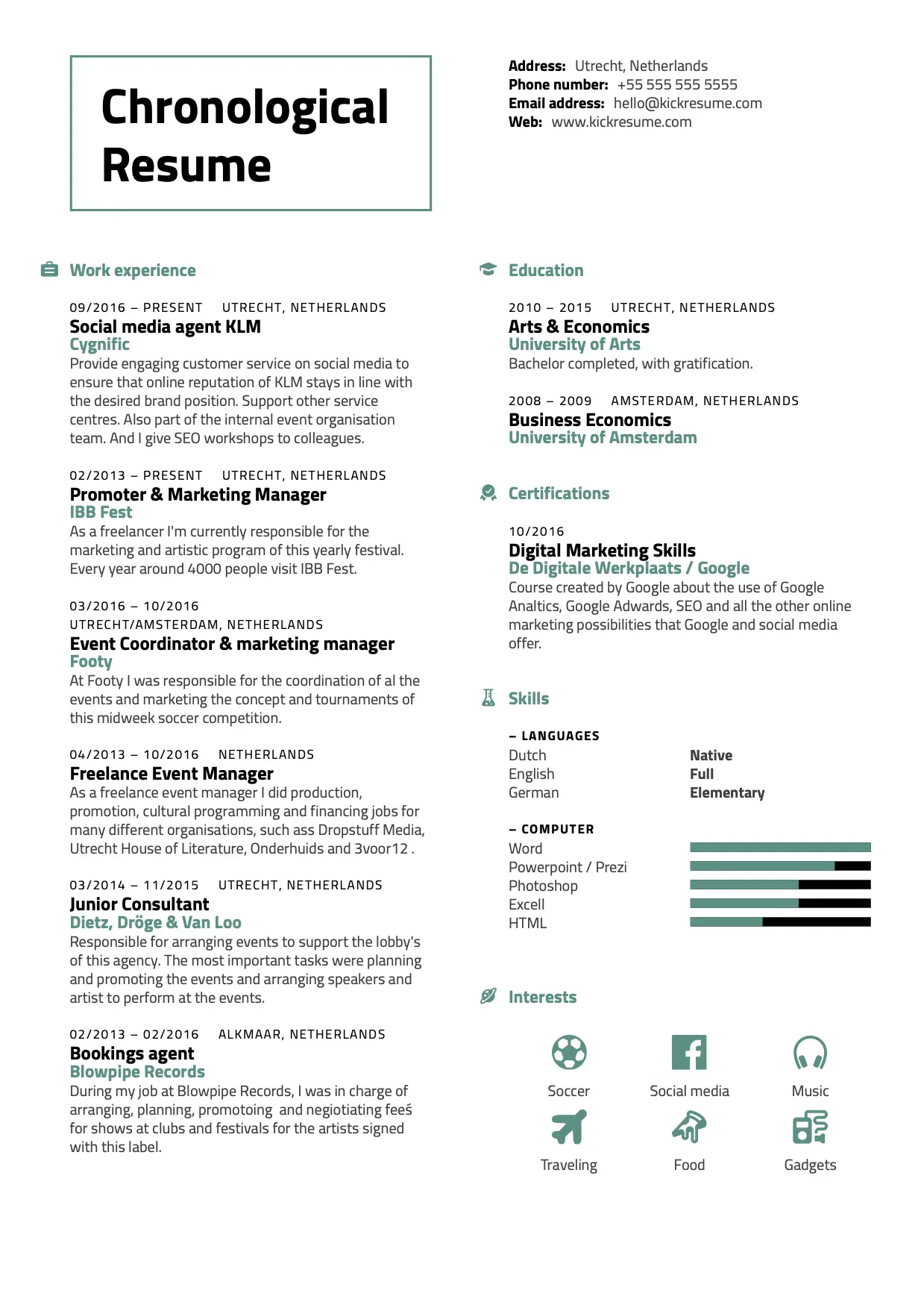
Functional resume format

Combined resume format
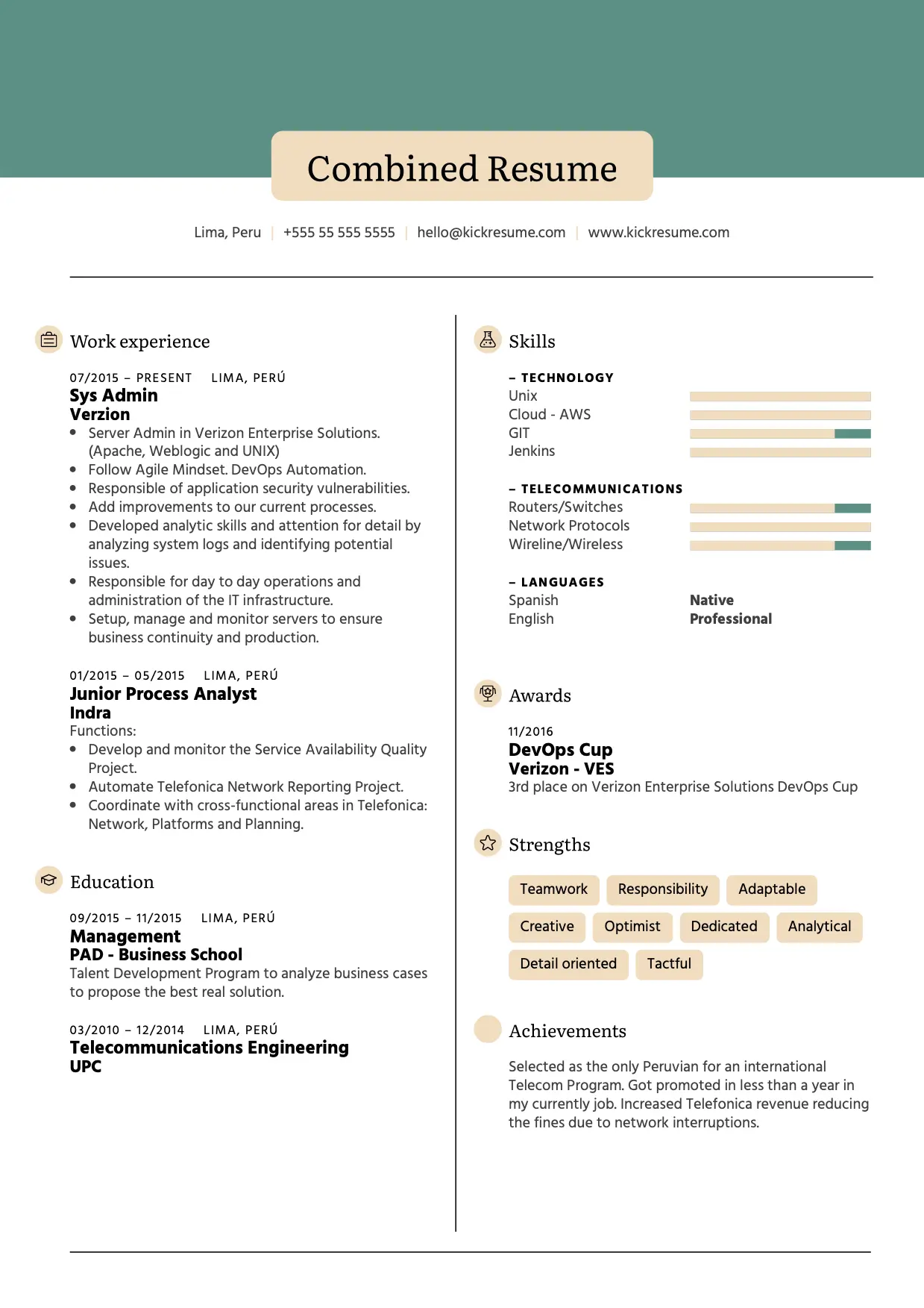
The resume format you choose will determine how you organize the information on your resume. It will also attract attention to some things and away from others.
Take time to understand your strengths and weaknesses and choose accordingly.
You want the recruiter to read the strongest and most relevant parts of your resume at the start. For more, check out a guide on how to choose the right resume format.

Step 2: Add contact information and personal details
Your contact/personal information should always be at the top of your resume in a so-called resume header.
Compared to the other resume sections, filling in the contact information section may seem super easy. That's until you start asking more questions.
Should you put your address on the resume? How to include social media, and should you? And what about the date of birth?
Well, let’s see:
- Name. Absolutely necessary. Put your first name first and surname last. Middle name is optional.
- Title. Optional. If you’re applying for a position in a traditional or specialized field, it's good to add your Ph.D., MBA, or other titles to it.
- Email address. Absolutely necessary, even when you’re sending your application by email. Your email address should look professional (e.g. john.day@gmail.com, NOT johnny69@gmail.com). Always use your personal email address, not the email address with the domain of your current employer.
- Home address. Somewhat problematic. Your neighborhood can say a lot about you in some cases, disclosing living in a certain area can lead to discrimination. On the other hand, if you’re located in the same city as the company, it may help you to get the job, as it saves the company that they'd have to spend on a relocation package (of course, only if the job isn't remote).
- Phone number. Necessary. Many employers will call you by phone to arrange an interview, instead of doing it by email.
- LinkedIn. Recommended. And if you don’t have a LinkedIn profile yet, consider creating one. Make sure your profile is complete and up-to-date.
- Social media. Optional. Include it only if it’s related to your job. GitHub, Behance, and even your Facebook or Instagram profile will do (if you regularly post content that has to do with your profession). Here are a few tips on how to include your social media.
- Blog/website. Optional. Similar to social media. If you have a blog, website, or digital portfolio related to your chosen profession, don’t be afraid to show it off.
- Photo. Problematic. It depends on the country. In most English-speaking countries, they don’t add a photo. See this guide to know if you should put a picture on your resume.
Step 3: Begin with your professional summary
Your professional summary should be a list of about 4-5 bullet points or a short paragraph that summarizes your relevant skills, experiences, and achievements.
You can think of it as a teaser for the rest of your resume. Make sure it’s interesting enough to hook the hiring manager right in.
But how do you write a good professional summary?
- Write your professional summary last. It’s surprisingly easy to do if you’ve already finished other sections of your resume.
- The first bullet point should describe your professional title. Don’t forget to add the number of years of experience. Write it in bold if the number is especially impressive.
- Pick the most impressive parts of your resume and rewrite them into snappy bullet points. Tease your potential employer into reading further.
- Pack your professional summary with relevant keywords. Think of ATS. This will help you get through automated pre-screenings.
- Quantify every achievement if possible. This will make you look even more professional.
- Tie every bullet point to the requirements introduced in the job offer.
If you do everything right, you should end up with something like this:
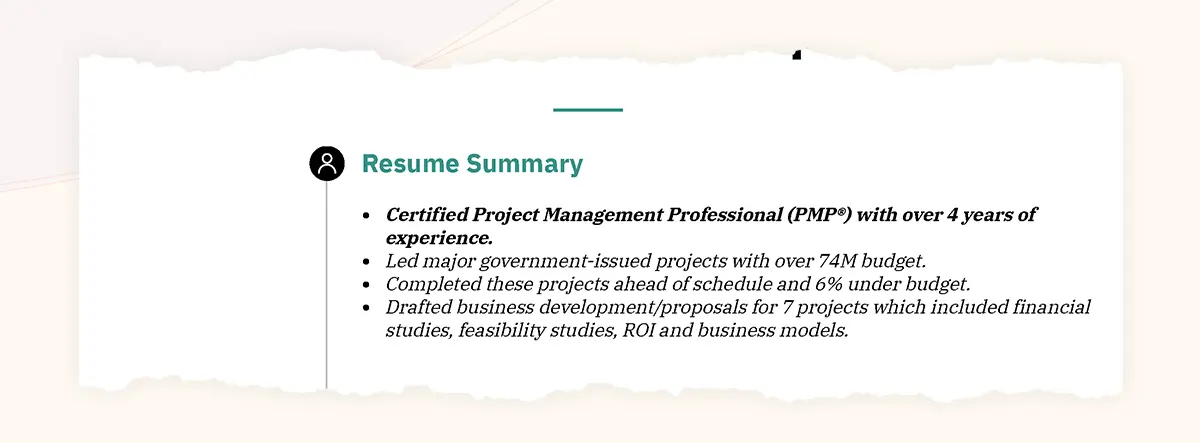
Step 4: List relevant work experience
The work experience section is what most people picture when they think “resume”.
The trick is to focus on your past achievements, not your responsibilities.
Hiring managers are likely to know what your responsibilities were supposed to be. In most cases, your job title says it all.
If you want to stand out, you should tell them how you excelled in your previous job instead.
And there’s hardly a more effective way to do that than by mentioning your achievements.
But how do you list your work experience on a resume?
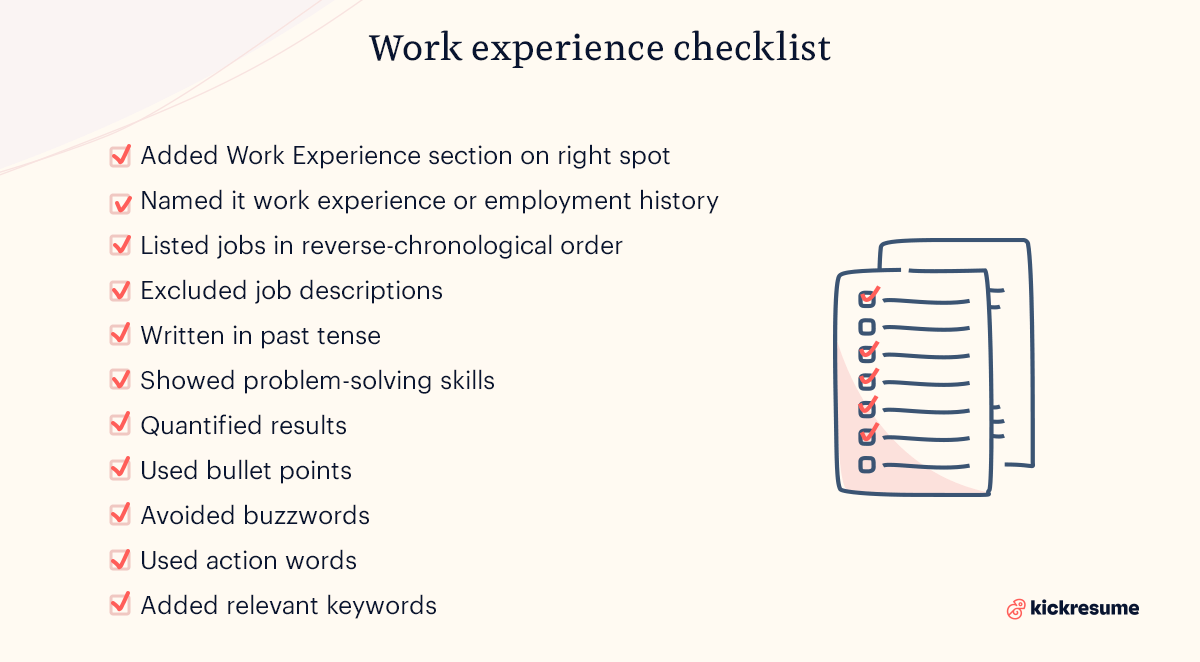
- Put your work experience section in the right spot. If you can boast a lot of professional experience, put your work experience section right under your resume summary. If you don’t have enough experience yet, put it just below your education section. Finally, if you prefer to highlight your skills instead of experience, put your skills section first.
- Give it a proper heading. Keep it simple and stick to “Work Experience” or “Employment History” as other headings might not be understood by applicant tracking systems (ATS).
- List your jobs in reverse-chronological order. Start with your most recent experience and work your way back from there. Based on your level of experience, decide how far back should your resume go.
- Don’t include the job description. Instead of listing what you were supposed to do, try to tell your potential employers what positive results you had.
- Write in past tense. This will help you focus on your past achievements instead of responsibilities. It also sounds better.
- Show your problem-solving skills. In the end, hiring managers want to know how effective you’re going to be in solving real problems. There’s no better way to show your problem-solving ability than to briefly describe how you solved difficult problems in the past. Follow the PAR scheme: What was the (P)roblem? What (A)ction did you take? What was the (R)esult?
- Quantify results. Hiring managers love measurable results. Because of that, a single number often speaks more than a thousand words. Don’t say that you “increased the company’s revenue significantly.” Instead, don’t be afraid to brag about “increasing the company’s revenue by 20%.”
- Use bullet points. Bullet points help you structure each subsection. Try to limit yourself to about 5 bullets per job.
- Avoid buzzwords. People used some phrases in their resumes so much, these words have become meaningless. Everybody seems to be an out-of-the-box creative thinker with a knack for innovation nowadays. But in reality, only very few people really are those things. See what other 10 buzzwords you should stop using on your resume
- Use action verbs. Unlike buzzwords, action verbs carry the weight you need to persuade an employer to hire you. Just to mention a few, these are words like “developed”, “increased”, “facilitated” and others. For more action verbs, check out our resume cheat sheet.
- Keywords. Reread the job description and carefully pick the most important keywords. These are the words that best describe the position you’re applying for, and that will attract the attention of the ATS system.
In the end, your work experience section should look a bit like this:

Step 5: Summarize your education
The education summary section is where you list your degrees and relevant academic accomplishments.
Based on your degree and where you're in your career, it can be either the least or the most important part of your resume.
Are you an experienced professional?
Once you become more experienced, the education section takes a back seat to your work history and hard skills.
In other words, your education section should come after your work experience section, not the other way around. It also shouldn't be too long. For instance, your grades are no longer relevant.
It’s enough if you include the name of your university, the name of your degree, and the year you graduated.
Here’s an example:

Are you a fresh graduate?
Then your degree is still one of the strongest cards you have to play.
In practical terms, it means that you should place your education section at the top of your resume — right between your professional summary and work experience section.
It should also be a bit longer.
These are the things you should add to your education section if you’re a student or a fresh graduate:
- Academic awards. AP scholar, Duke of Edinburgh award, National Merit Award, President’s Award, school subject-based awards, dean’s list, etc.
- Scholarships. Athletic scholarships, scholarships for women, creative scholarships, etc.
- Academic conferences and symposia. Don’t forget to mention the scope and name of the paper you presented at a conference.
- Relevant student societies. Debating or programming clubs. If you were on a student committee of any kind, mention that too.
- GPA. Only include your GPA if it was higher than 3.0 on a 4.0 scale. If your overall GPA was lower, mention your overall GPA. Alternatively, mention your summa cum laude or magna cum laude.
- Academic publications. Producing an academic work worth publishing is impressive no matter the context.
In the end, your education section can look like this:

Step 6: Highlight your soft and hard skills
Before you start writing, you should know there are two types of skills: hard skills and soft skills.
1. Hard skills can be learned, taught, and most importantly — measured. Acquiring them requires deliberate effort, training, and time.
Hard skills can be, for instance: computer skills, language skills, manual skills, mathematics, project management, etc.
2. Soft skills are tied to your personality traits. These skills can come as part of your upbringing, or you can acquire some later in life through self-improvement. These skills can bring value to any job, as well as your private life.
Examples of soft skills include: communication, leadership, time management, creativity, decision-making, etc.
But how to make your skills stand out?
- Focus on what’s most relevant. Do you have any of the skills mentioned in the advertisement for your desired job? Good. Make sure to include them in your resume’s skills section.
- Organize your skills into subcategories. Divide your skills section into several subsections like computer skills, soft skills, languages, and others.
- Don’t underestimate soft skills. 67 percent of HR managers said they’d hire a candidate with strong soft skills even if their technical abilities were lacking. On the contrary, only 9 percent would hire someone with strong technical credentials but weak soft skills.
- There are skills you shouldn’t include. Never include any skills you don’t have, skills that have nothing to do with the job, skills everybody should have, or skills that have become obsolete.

Step 7: Add optional resume sections
Apart from the standard resume sections we just mentioned above, are also optional sections.
A good rule of thumb is to add an optional section only if it's relevant to the job you're applying for. If done properly, these sections can help you:
- Fill the gap when lacking experience
- Highlight additional skills and expertise
- Let an employer know more about who you are
Here are some of the most common optional sections:
Technical skills
This section can be a nice addition when applying for (surprise!) technical jobs.
Some examples of technical skills are: programming languages, software proficiency, project management, and data analysis.
Technical skills are usually measurable, so if you decide to include them in your resume, use a graph or a scale to illustrate how strong they are. Adding visual elements to your resume not only looks nice but also shows your ability to be precise and analytical.
Achievements and awards
Scholarships, competitions, work-related awards, or even promotions to leadership positions in your job — all of these can be considered important professional achievements.
Either distribute them across other parts of your resume or put them in a dedicated section. The latter allows you to truly highlighted them.
And if you choose to include them in a separate resume section, don't forget to mention the dates and the name of the company/institution at which you've accomplished the achievement.
Professional references
In today's competitive job market, strong professional references can be a game-changer. Consider including a 'Professional References' section in your resume to provide potential employers with easy access to these valuable resources.
How to format references on resume? Here's what you should list for each reference:
- Their full name
- Their current job title and organization
- Their contact details (email and phone number will do)
- Your relationship with them (e.g., Former Supervisor)
Ensure you have their permission and inform them when actively job searching.
Once you decide who you want your references to be, it's time to ask them if they agree. Here's how to ask someone to be a reference via email.
Certifications and licenses
Listing the certificates and courses that you've successfully completed on your resume is never a mistake.
However, keep in mind that they should be related to the role that you're applying for.
If you'd like to add a certificate to your CV but you're unsure about where to find the best course for you, check out this carefully curated list of the best online courses that will help you to get a job.
Publications
In this section, you can mention all the relevant conferences, presentations, and written publications.
This section is most useful if you're working in academia, marketing, or journalism.
However, include it in your resume also if you're applying for a position that requires you to be an expert on the topic that you've written about.
Volunteering
This section lists your volunteer work. It should be treated similarly to a work experience section. The reason is that whether your work was paid or not, it still translates to real-life experience.
This is true especially if you find yourself at the beginning of your career. In that case, feel free to place the volunteering section towards the start of your resume.
On the other hand, if you're a seasoned professional, locate this section more toward the end of your document.
Hobbies
This is the part of your resume that's the most personal. Here, let a little loose and let your personality shine through. List you hobbies and interests, even the quirky or unique ones.
Hobbies serve as a great way for a hiring manager to see you more as a person and less as just a name written on a paper. They can also break the ice during the interview stage.
Step 8: Wrap it up with a cover letter
Phew! Almost done with how to write a resume. Just a little bit of editing and proofreading, picking the right resume template, and you should be able to click send, right?
Well, not quite. At least we wouldn’t recommend you sending it — yet.
The truth is that resumes are often put aside when not accompanied by a cover letter. It would be a shame if this happened to you, especially after all the time you’ve spent creating it.
A good cover letter is a way to stand apart from the competition. It’s where you can show your hiring manager you mean business.
And, if you're fresh out of college or changing career this step-by-step guide on how to write a cover letter with no experience will show you what to focus on instead.
Here are 4 questions to guide you while writing your cover letter:
- Who are you (professionally)?
- Why are you interested in working for their company?
- Why are you the best fit for the job opening?
- How can you enrich their company?
When all it’s said and done, your cover letter should look something like this:
Want more inspo? Browse another 1,250+ cover letter examples by your profession.
And if you really want a memorable cover letter, we’ve got you covered. In fact, we’re certain it will be the only cover letter guide you’ll ever need.

Final tips before you click “Send”
- The older the job, the fewer the details. In other words, don’t have 13 bullet points on a job from 5 years ago.
- Use off-peak hours for maximum attention, especially if you’re reaching out to an employer directly. Hiring managers are busy people and you want them to receive your resume when they have enough time to carefully read through it.
- Check your resume for typos. If English isn't your first language, employers might be inclined to overlook any grammatical mistakes that you make in your resume. Typos, on the other hand, are unforgivable. Your computer’s spell-check feature can help you fix that.
- Customize your resume for each job application. Every employer is different. And any hiring manager can tell if you’ve just sent them the same generic resume as to everyone else. So make sure you tailor your resume to each individual employer to increase your chances of getting hired.
- Get the introductory email right. It doesn’t matter that you have the best resume ever if nobody gets to read it. Attach it to an email that catches the employer’s attention from the get-go. Pay particular attention to the subject line that will make them read the full email, including the attachments.
FAQ: How to write a resume
- How many pages should a resume have?
One to two pages is the ideal. If you're at the junior stage of your career, one page is more than enough. Similarly, make sure that your resume isn't longer than three pages (and this may be stretching it already), even if you're a CEO.
- Does your resume's design matter?
Generally speaking, content is superior to form when it comes to resumes. However, a nice design is the first thing that catches the recruiter's attention — and that's precisely what you want. Moreover, if you're looking for a job in marketing, art, or design, the design of your resume naturally becomes your selling point, too.
- What are the biggest resume mistakes?
Typos, being too general and not specific enough, not including relevant information, not using action verbs, and writing about duties instead of accomplishments.
- In what format should I send my resume?
The best format for sending a resume is PDF, as it keeps the visuals of the resume unchanged once the document is opened by the recruiter.
- How to format a resume?
1. Include standard resume sections. Contact information, resume summary, work experience, education, skills.
2. Include optional resume sections. Awards, references, certifications, publications, projects, etc.
3. Choose a resume format. The three standard are: chronological, functional, combination.
4. Use bullet points. Use bullet points to make your resume easier to scan and highlight important information quickly.
6. Think about the margins. Strike a good balance between not leaving too much white space and making your resume seem cluttered.
7. Keep it to one-two pages. Unless you have extensive work experience, you should generally aim to keep your resume to one page.
8. Consistency is key. In all aspects of your resume, including the spacing, font, margins, etc.
9. Use a professional resume template or layout which helps to structure the information effectively and makes it easy to read.
Good job, you made it! If you still need more information on how to write a resume. You can go further in-depth in our section-by-section resume guide.
This article was recently updated. The original article was written by Noel Rojo in 2019.
